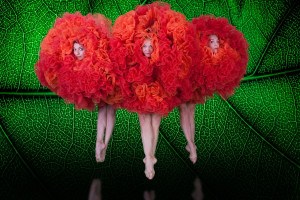THEATER REVIEW: Love in the Midst of War in South Pacific

The Cast of South Pacific at the Walnut Street Theatre
In the opening moments of South Pacific at Walnut Street Theatre, the orchestra plays the intoxicating strains of “Bali H’ai” as we watch a slide show of smiling servicemen and women. Gradually, members of cast assume similar poses, becoming visible behind a scrim — the snapshots have merged with real people.
This hauntingly lovely moment is terrific kick-off for director Charles Abbott’s often-smashing production, and it reinforces an important point about South Pacific and its setting. When the landmark Rodgers and Hammerstein show premiered in 1949, World War II was still very much part of the present; today, it’s history.
In many ways, the passing decades have enhanced it. Our sense of wartime heroism grows deeper with time, while Rodgers and Hammerstein’s score (to my mind, their best after Carousel) feels fresh and thrilling, an astonishing cornucopia of blue-chip songs. The first scene alone brings four numbers in rapid succession — “Dites-moi,” “A Cockeyed Optimist,” “Twin Soliloquys,” and “Some Enchanted Evening.” Any one of them is a home-run. Heard together? Wow. The show’s central love story — between Nellie Forbush, an American army nurse, and Emile De Becque, a French planter now living in the South Sea islands — remains compelling; the show’s then-revolutionary message about the perils of racism still resonates.
Walnut’s production is at its considerable best in the exuberant group scenes, where the ensemble casts, both male and female, are superb in every way — vocally assured, characterful, brimming with energy. In “There Is Nothing Like a Dame,” the boys bring down the house; later, the girls do the same with the reprise of “A Wonderful Guy.” Among the featured performers, there’s especially strong work by Ben Michaels as a dreamy Lieutenant Cable, and Paul Schoeffler, an elegantly suave De Becque (and more convincingly French than most), especially good in “This Nearly Was Mine.” Kate Fahrner (Nellie) sings well, but the character emerges a brassy type, rather than a complex and conflicted individual. A particular strength of Abbott’s direction is that the songs are uncommonly well-bound into the narrative fabric.
In these big moments, the show feels new-minted, but other aspects haven’t aged so well. What are we to make of Bloody Mary, a local war profiteer (she’s South Pacific’s Mother Courage), largely presented as a comedic figure, who pimps out her young daughter, Liat? It’s a troubling subplot at best. Director Charles Abbott neither modifies nor soft-soaps these scenes, but presents them full-out — I think it’s the smartest choice, but some audiences may be put off. (That Lori Tan Chinn gives a virtuoso, crowd-pleasing performance is, ironically, a complicating factor.)
The look of this South Pacific (scenery by Robert Andrew Kovach, lighting by Paul Black) evokes a tropical paradise in glorious technicolor. This is especially apt for the opening scene in De Becque’s garden, which here we see through Nellie’s idealized gaze.
But that glow never quite dissipates. Part of the power of South Pacific is the pervading sense that danger, exhaustion, and the real possibility of defeat hover over even its most joyful moments. Surely, the 1949 audiences understood this instantly. Today at the Walnut Street, the devastation of war seems far away.
In this context, too, South Pacific is a bit of a postcard — a beguiling scene that isn’t quite the whole picture.
South Pacific runs through October 23. For more information, visit the Walnut Street Theatre website.


